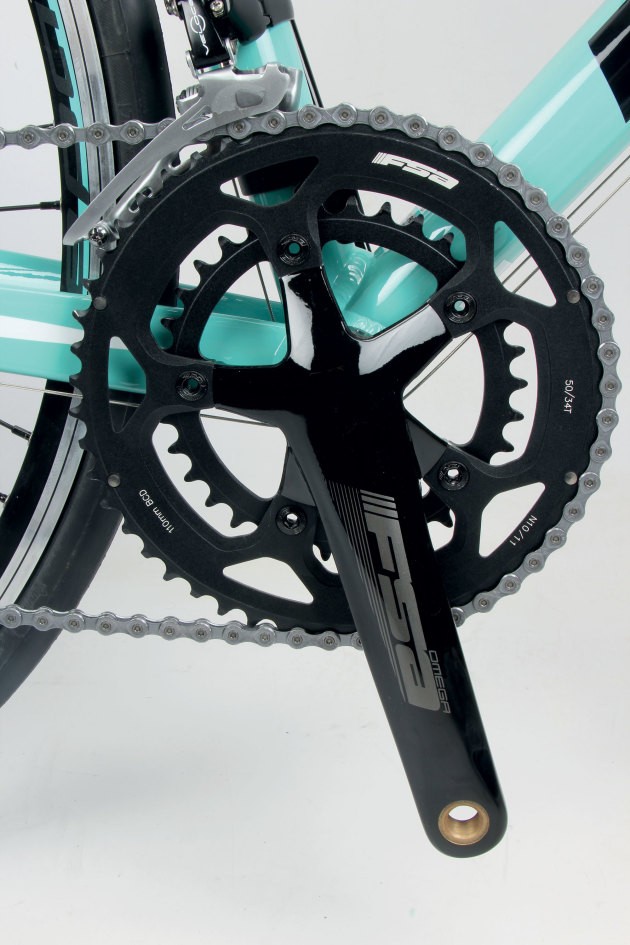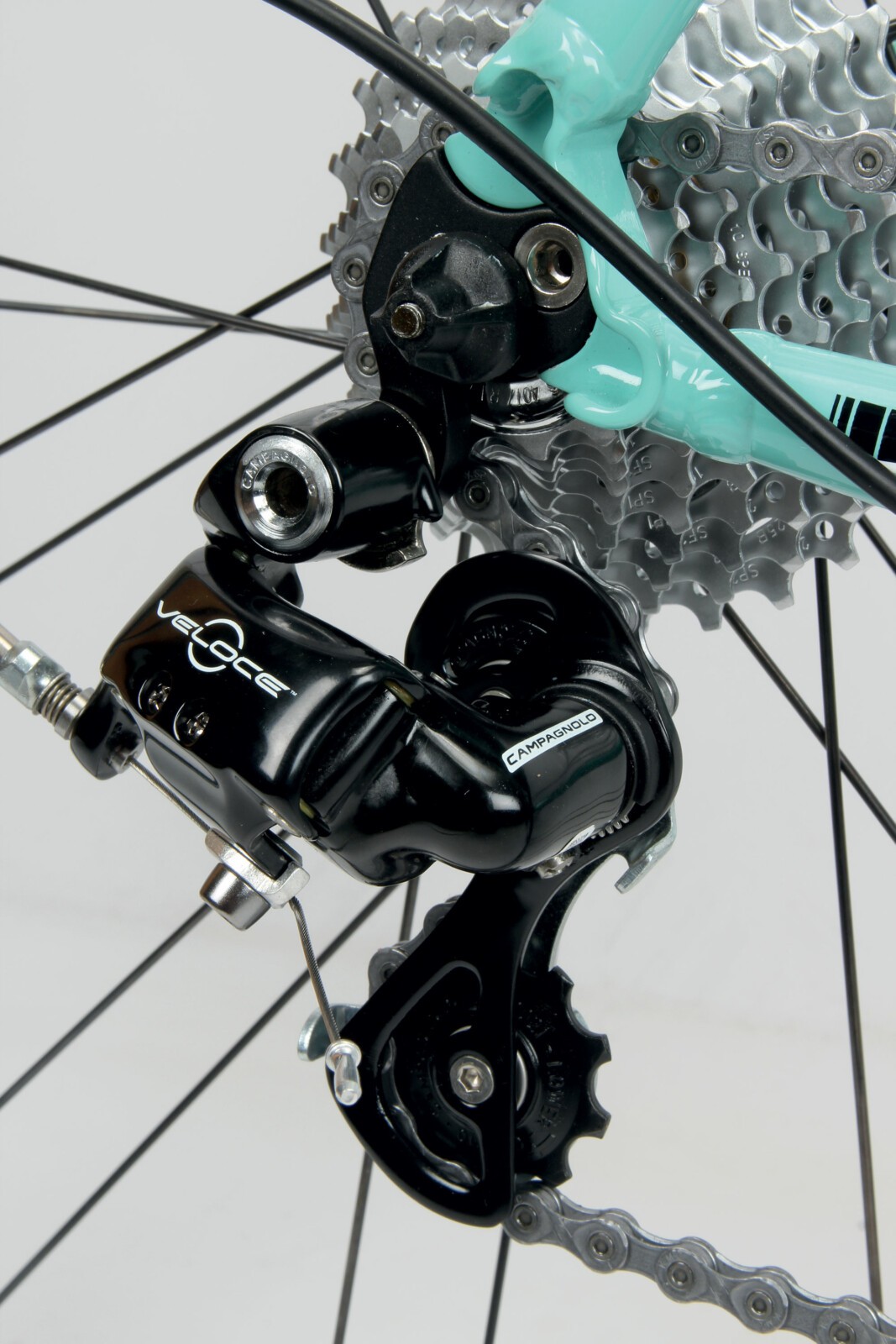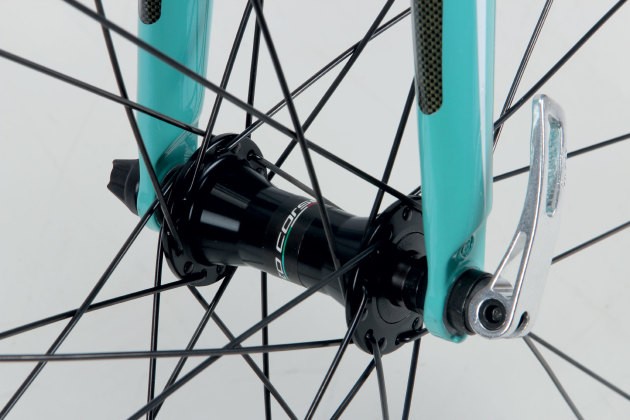Four years is a reasonable innings in the bicycle game, especially for a frame. Bianchi’s alloy everyman Impouslo has been in the Italian brands line up since 2012, remaining unchanged to this day. Rather than creating an entry level bike from carbon, the Impulso relies on heavily formed alloy tubes. Pantani fans will be satisfied by Bianchi’s willingness to continue with the frame material that the enigmatic climber made so famous for Celeste emblazoned devotees.
The Impulso occupies some of the space in Bianchi’s ‘Endurance Racing’ line up. As with the carbon Intenso model that we rode in the last issue of BA, the Impulso’s fit is more of a relaxed-fast than out and out leisurely. Most riders will be able to find a nice spot aboard the Impuslo, regardless of whether they like a lower and aggressive position or a relaxed and upright. Correspondingly the wheelbase is a handful of millimetres longer than Bianchi’s race offerings, adding a degree of stability to the Impuslo as speeds rise.

Some alloy bikes stand out in a crowd whereas others require close inspection. From the rear it’s easy to pick the Impulso’s welds and tubes, but the frontal view is quite unique. The headtube and top tube are both hydroformed, then welded together, before being hyrdoformed again as one piece. This three step process gives the flowing and smooth look of a carbon frame and is reputedly 10% stiffer than the same structure had it not been hydroformed the second time. The rest of the Impulso’s tubeset varies in girth and shape constantly, balancing weight and ride quality considerations. Mechanics will be happy to see that all the cables are externally routed, giving the Impulso a slightly retro look when combined with its alloy tubes, slender fork and Celeste paintjob.
Given the endurance aspiration of the Impulso we’d expect a chassis designed with comfort as one of, if not the key metric of performance. Alloy is a stiff material by nature and has a wrap for being a rough rider, but this harks all the way back to Pantani’s heyday when tubes were big and hydroforming was unheard of. In the modern context it’s akin to panning carbon frames for being dangerously fragile, which most folks seem to have successfully moved past. The complete Impulso was not light by any stretch, which makes it feel a bit clunky over bumps in the road, but it does a reasonable job of filtering road buzz when you’re humming along through the countryside and it’s not nearly as unpleasant as alloys reputation might lead you to assume.

The Impuslo delivers plenty of road feedback which I found to be just to my liking. It’s far from muted but it stops before becoming wrist numbingly direct. The frame is extremely rigid when you’re out of the saddle and swinging it about, the rear wheel follows the front like it’s tracking with a lazer. You can put plenty of body language into your riding knowing that your bike isn’t going to squirm about and dull the edges of the crisp lines you’re laying on the road. The downside of the responsiveness is that the Impulso is more likely to break traction on steep climbs or bumps in the road, it’s just too rigid to track and hold the surface if you’re lazy about your weight placement and torque delivery. The chain stays are very tall for an alloy frame; on the road they hold the rear wheel in place ferociously. The alloy steerer of the fork keeps things quite taut up front, despite its old school straight 1 1/8 steerer.

If European bikes are meant to be about passion and ‘feel’ the Impulso delivers in full. The Campagnolo Veloce drivetrain might not be as smooth as the similar priced Shimano and SRAM offerings but it’s poles apart when the tactile experience is considered. We don’t get to ride many Campagnolo equipped bikes these days, but it’s always a pleasure. The curvaceous hoods and lever blades are in my mind peerless in comfort. Their tall peak keeps your hand in place on bumpy descents and their textured hoods are for some reason a feature that is only found on other manufacturers top end groupsets. The shift action is noisy and mechanical. It’s no accident either, it’s trademark Campagnolo. The downshift of the front derailluer was more clunky than we’d have liked and the rear upshift paddle only shifts one gear at a time on Veloce (higher end groups shift multiple gears in a satsifying clack clack clack of Italian engineering) but everything was reliable and the shift feedback was a perfect compliment to the ride of the frame, delivering a ride that involves the rider in each decision and process rather than automating or circumventing the rider.

The Impulso is more ideally situated to be ridden hard and fast than slow and steady. It’s certainly happiest when given some pepper by the rider. The stock Bianchi wheels are far from sprightly so perform best once the speed is ramped up and kept there. On smooth roads the Bianchi will happily roll hard turns and attack small rises with gusto. At lower speeds the road feedback might be more than some riders are looking for, and the total bike weight becomes more noticeable. The Impulso is one for the more honest riding bikes you’re likely to encounter. It’s happy to play hard and and it really communicates with the rider.

Summing Up
Quality
The Impulso is very functional. There’s nothing outlandish here, what you see is what you get.
There was a hole in the paint on the top tube, which was a shame.
Performance
Sporty and firm, the Impulso is taught and fast ride if ridden hard. It has a very distinctive road feel that sets it apart from many competitors.
Value
Up against many carbon bikes the Impulso may look a little simple. The Campagnolo group is a real feature that will appeal heavily to some riders.
Overall
Another unique bike from Bianchi that doesn’t fit the expected convention. The ride of the
Impulso is more likely to appeal to experienced riders and the look is pleasingly retro.

Specifications
FRAME: 6061 Alloy. Hydroformed and triple butted
FORK: Alloy steerer with carbon blades and kevlar
SHIFTERS: Campagnolo Veloce
FRONT DERAILLEUR: Campagnolo Veloce
REAR DERAILLEUR: Campagnolo Veloce
CRANK: FSA Omega MegaExo Compact
CASSETTE: Campagnolo Centaur
BOTTOM BRACKET: FSA
WHEELS: Reparto Course Racing
TYRES: Vittoria Zaffiro Slick 25mm
BRAKES: Reparto Course Alloy Dual-pivot
HANDLEBAR: Reparto Course Alloy Compact Bend
STEM: Reparto Course Alloy
HEADSET: FSA Zero Stack Drop In Cartridge
SADDLE: Selle San Marco Era Startup Power
SEATPOST: Reparto Course Alloy
WEIGHT: 9.4kg
PRICE: $2,299
DISTRIBUTOR: Sola Sports




